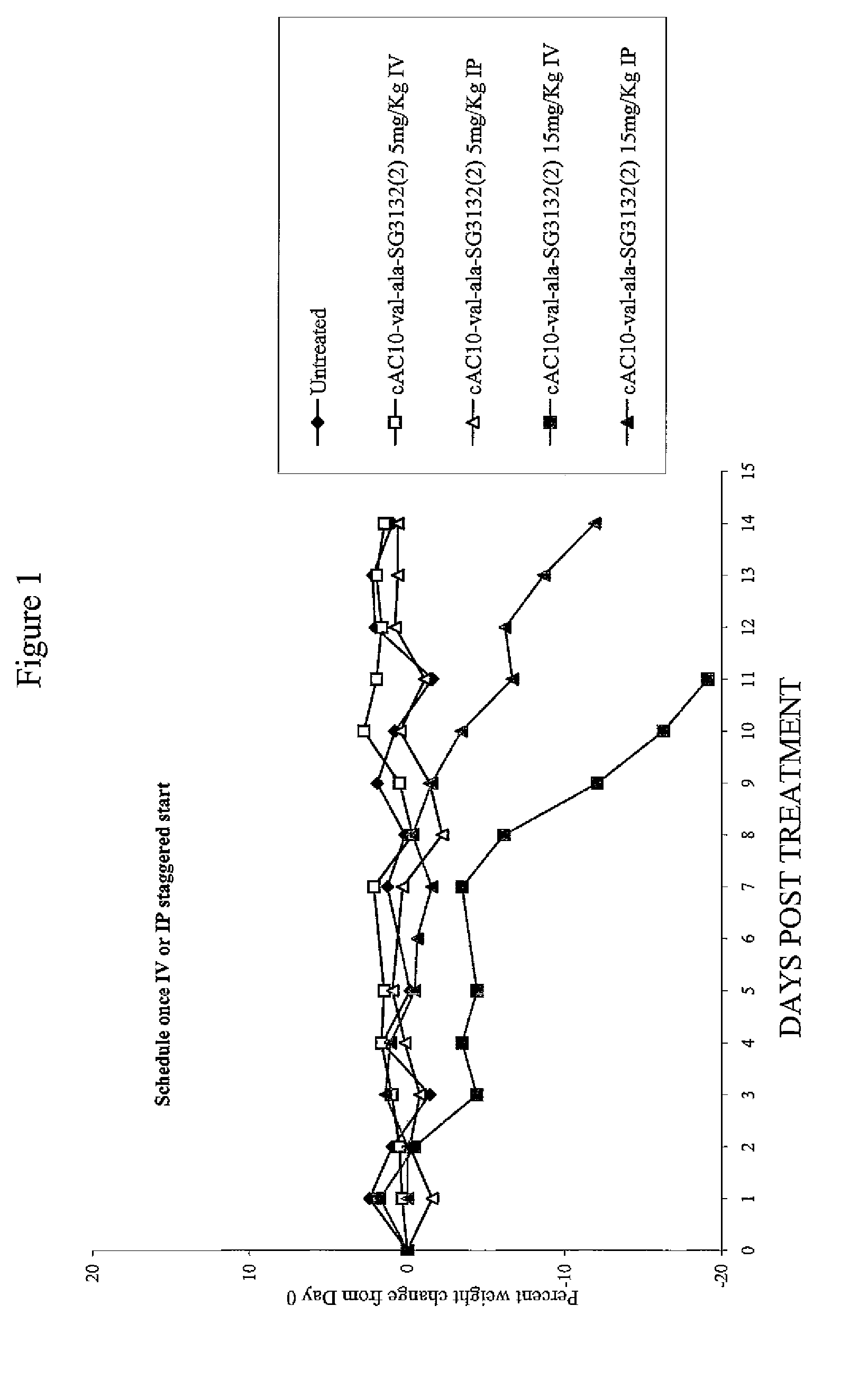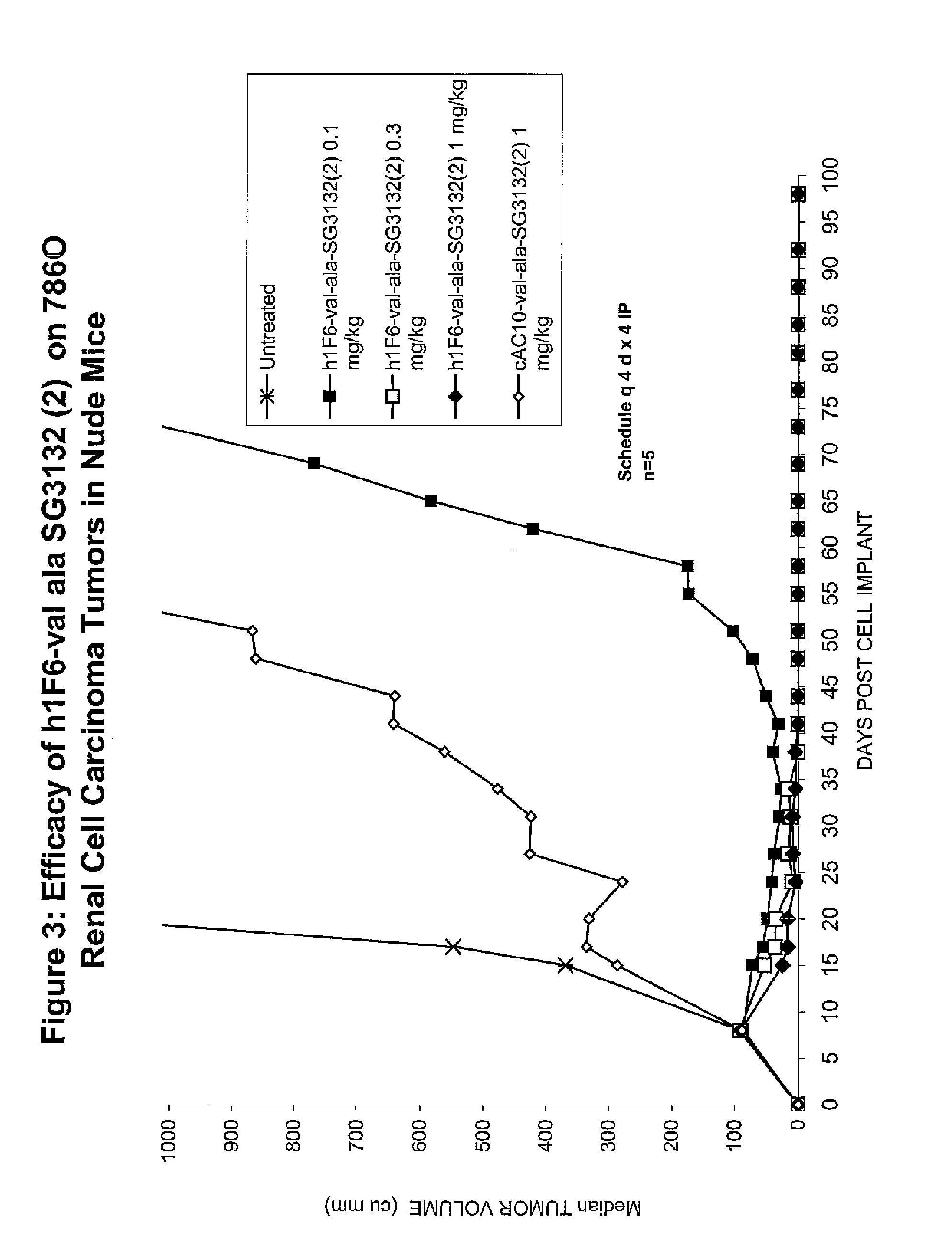Targeted pyrrolobenzodiazapine conjugates
a technology of pyrrolobenzodiazapine and conjugates, which is applied in the field of targeted pyrrolobenzodiazapine conjugates, can solve the problems of limited options for preparation of targeted conjugates containing pbds, and achieve the effects of reducing toxicity, good potency, and potent cytotoxic and/or cytostatic activity
- Summary
- Abstract
- Description
- Claims
- Application Information
AI Technical Summary
Benefits of technology
Problems solved by technology
Method used
Image
Examples
example 1
[0621]
(a) (S)-2-(4-aminophenyl)-7-methoxy-8-(3-((S)-7-methoxy-2-(trifluoromethylsulfonyl)-5,11-dioxo-10-((2-(trimethylsilyl)ethoxy)methyl)-5,10,11,11a-tetrahydro-1H-pyrrolo[2,1-c][1,4]benzodiazepin-8-yloxy)propoxy)-10-((2-(trimethylsilyl)ethoxy)methyl)-1H-pyrrolo[2,1-c][1,4]benzodiazepine-5,11(10H,11aH)-dione (9)
[0622]Solid Pd(PPh3)4 (20.18 mg, 17.46 mmol) was added to a stirred solution of the triflate 8a (975 mg, 0.87 mmol), 4-(4,4,5,5-tetramethyl-1,3,2-dioxaboralane-2-yl)aniline (172 mg, 0.79 mmol) and Na2CO3 (138 mg, 3.98 mol) in toluene (13 mL) EtOH (6.5 mL) and H2O (6.5 mL). The dark solution was allowed to stir under a nitrogen atmosphere for 24 hours, after which time analysis by TLC (EtOAc) and LC / MS revealed the formation of the desired mono-coupled product and as well as the presence of unreacted starting material. The solvent was removed by rotary evaporation under reduced pressure and the resulting residue partitioned between H2O (100 mL) and EtOAc (100 mL), after event...
example 2
[0628]
(a) (S)-2-(4-aminophenyl)-7-methoxy-8-(5-((S)-7-methoxy-2-(4-methoxyphenyl)-5,11-dioxo-10-((2-(trimethylsilyl)ethoxy)methyl)-5,10,11,11a-tetrahydro-1H-pyrrolo[2,1-c][1,4]benzodiazepin-8-yloxy)pentyloxy)-10-((2-(trimethylsilyl)ethoxy)methyl)-1H-pyrrolo[2,1-c][1,4]benzodiazepine-5,11(10H,11aH)-dione (12)
[0629]Solid Pd(PPh3)4 (32 mg, 27.7 μmol) was added to a stirred solution of the bis-triflate 8b (1.04 g, 0.91 mmol) in toluene (10 mL), EtOH (5 mL), with 4-methoxyphenyl boronic acid (0.202 g, 1.32 mmol), Na2CO3 (0.169 g, 1.6 mmol), in H2O (5 mL) at 30° C. The reaction mixture was allowed to stir under a nitrogen atmosphere for 20 hours. Additional solid 4-(4,4,5,5-tetramethyl-1,3,2-dioxaboralan-2-yl)aniline (0.203 g, 0.93 mmol) and Na2CO3 (0.056 g, 0.53 mmol) were added followed by solid Pd(PPh3)4 (10 mg, 8.6 μmol). The reaction mixture was allowed to stir under a nitrogen atmosphere for a further 20 hours. LC / MS indicated the formation of desired product. EtOAc (100 mL) and H2O...
example 3
[0633]
(a) (S)-2-(thien-2-yl)-7-methoxy-8-(3-((S)-7-methoxy-2-(trifluoromethanesulfonyloxy)-5,11-dioxo-10((2-(trimethylsilyl)ethoxy)methyl)-5,10,11,11a-tetrahydro-1H-pyrrolo[2,1-c][1,4]benzodiazepin-8-yloxy)propyloxy)-10((2-(trimethylsilyl)ethoxy)methyl)-1H-pyrrolo[2,1-c][1,4]benzodiazepine-5,11(10H,11aH)-dione (14)
[0634]Solid Pd(PPh3)4 (41 mg, 0.036 mmol) was added to a stirred solution of the bis-triflate 8a (1 g, 0.9 mmol) in toluene (10 mL), EtOH (5 mL), with thien-2-yl boronic acid (149 mg, 1.16 mmol), Na2CO3 (152 mg, 1.43 mmol), in H2O (5 mL). The reaction mixture was allowed to stir under a nitrogen atmosphere overnight at room temperature. The solvent was removed by evaporation in vacuo and the resulting residue partitioned between H2O (100 mL) and EtOAc (100 mL). The aqueous layer was extracted with EtOAc (2×30 mL) and the combined organic layers washed with H2O (50 mL), brine (50 mL) dried (MgSO4), filtered and evaporated in vacuo to provide the crude product which was puri...
PUM
| Property | Measurement | Unit |
|---|---|---|
| general structure | aaaaa | aaaaa |
| electrophilic | aaaaa | aaaaa |
Abstract
Description
Claims
Application Information
 Login to View More
Login to View More - R&D
- Intellectual Property
- Life Sciences
- Materials
- Tech Scout
- Unparalleled Data Quality
- Higher Quality Content
- 60% Fewer Hallucinations
Browse by: Latest US Patents, China's latest patents, Technical Efficacy Thesaurus, Application Domain, Technology Topic, Popular Technical Reports.
© 2025 PatSnap. All rights reserved.Legal|Privacy policy|Modern Slavery Act Transparency Statement|Sitemap|About US| Contact US: help@patsnap.com



